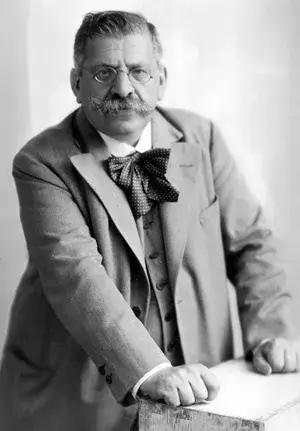This month’s Trans History Spotlight shines on a moment that should never be forgotten: the destruction of the Institute for Sexual Science (Institut für Sexualwissenschaft) in Berlin, Germany. Nearly a century ago, on May 6, 1933, Nazi stormtroopers ransacked one of the most groundbreaking institutions in the world, dragging books, research, and medical records into the streets and setting them ablaze. It was an attack on knowledge, on history, and on the very existence of trans and queer people.
The story of the Institute and its burning is more than just a historical event—it is a warning from the past. Today, as gender-affirming care faces relentless attacks, as books about trans lives are banned, and as misinformation is spread to justify discrimination, the echoes of the past are impossible to ignore. Understanding what happened to the Institute for Sexual Science, why it was targeted, and what was lost in the flames is crucial in resisting today’s efforts to erase transgender people from public life.
Table of Contents
What the Institute for Sexual Science Stood For
Founded in 1919 by Dr. Magnus Hirschfeld, the Institute for Sexual Science (Institut für Sexualwissenschaft) was revolutionary. Hirschfeld, a gay Jewish doctor and sexologist, was a fierce advocate for LGBTQ+ rights at a time when such advocacy was rare and dangerous. He coined the term “transvestite” (an early term for transgender people) and dedicated his life to researching and supporting gender-diverse individuals.
The Institute was more than just a research center—it was a safe haven. It provided some of the world’s earliest gender-affirming healthcare, including hormone therapy and gender-affirming surgeries. It offered psychological counseling, legal aid, and a space for people to exist as their true selves without fear.

Trans and gender-diverse people from all over Europe sought refuge and medical support there, and it housed one of the most extensive archives on LGBTQ+ identities ever assembled.
This was a place of knowledge, of progress, of human dignity. And that was precisely why the Nazis wanted it destroyed.
The Night the Nazis Tried to Erase Queer History
In early 1933, Adolf Hitler had just risen to power. The Nazi regime wasted no time enforcing its vision of a “pure” and “moral” society, one that excluded LGBTQ+ people, Jewish people, and anyone who did not fit into their rigid ideology. Hirschfeld, both gay and Jewish, was an obvious target.
On the evening of May 6, a group of Nazi youth and SA stormtroopers stormed the Institute. They ransacked its offices, destroying medical files, patient records, and groundbreaking research that had been decades in the making. They seized thousands of books, journals, and photographs documenting queer existence and dragged them into the streets.
Three days later, on May 10, the Nazis staged one of their infamous book burnings in Berlin’s Opernplatz. In front of a roaring crowd, they set fire to more than 20,000 books and documents from the Institute’s archives. This was no random act of destruction; it was a calculated attempt to erase queer and trans people from history.
And it worked—for a time. The loss of that research set back transgender healthcare for decades. Hirschfeld, who had been on a lecture tour in France at the time, never returned to Germany. He died in exile two years later, heartbroken.
Echoes of the Past: The Parallels to Today’s Attacks on Trans People
History doesn’t repeat itself exactly, but it often rhymes. Today, we are witnessing a chilling resurgence of state-backed efforts to erase and discredit transgender people. In the United States, politicians like Donald Trump and his allies are waging an all-out war on gender-affirming care. Laws banning access to transition-related healthcare are sweeping the country. Medical professionals are being threatened for providing research-backed, lifesaving care. Books about gender identity are being banned from schools and libraries. And misinformation is being spread at an alarming rate, all with the same goal: to erase trans people from public life.
Much like the Nazis targeted Hirschfeld’s work because it challenged their vision of an exclusive, homogenous society, today’s far-right movements are attacking trans healthcare because it challenges their rigid, binary worldviews. The same fear-driven rhetoric is being used—claims that trans people are a threat, that gender-affirming care is “mutilation,” that acknowledging queer identities will “corrupt” society. These are not new arguments; they are the same ones used to justify the destruction of the Institute for Sexual Science nearly a century ago.
What We Can Learn—and How We Fight Back
The Nazis burned the Institute’s archives, but they could not burn the truth. The knowledge that Hirschfeld and his colleagues uncovered did not vanish; it resurfaced in later decades through the work of trans activists, medical professionals, and historians who refused to let it be forgotten. The resilience of the trans community has always been stronger than any attempt to erase it.
But we cannot be passive in the face of today’s attacks. The parallels are too stark, the dangers too real. We must protect trans healthcare, advocate for policies that support gender-affirming care, and push back against misinformation with facts, research, and lived experience. We must document our history and safeguard our stories so that no one can claim we never existed.
In 1933, the Nazis tried to destroy trans people’s right to exist. They failed.
Today’s anti-trans extremists are trying again. And once again, they will fail—so long as we speak out, hold onto our history, and fight relentlessly for the future.



